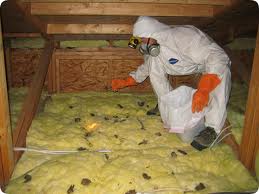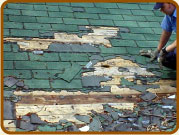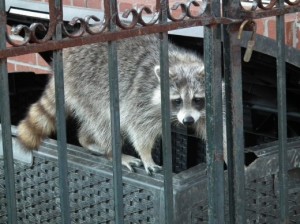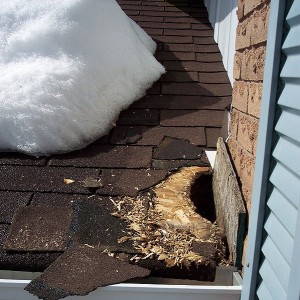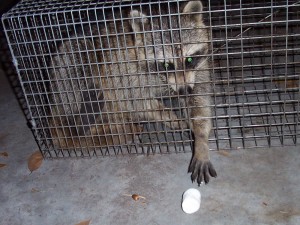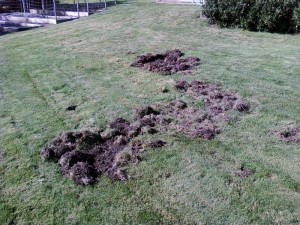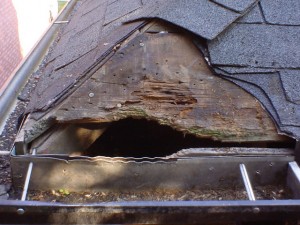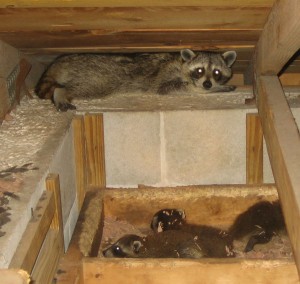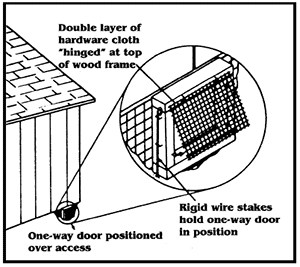 The picture on the left shows a lot of raccoon poop or raccoon scat as many people call it. Raccoons have been in this attic for a long time judging by the amount of raccoon scat laying on top of the insulation. There is probably more raccoon scat underneath and then there is the urine. This is a big problem for this homeowner and he or she needs to make arrangements to remove the raccoon scat and also the insulation in a safe manner.
The picture on the left shows a lot of raccoon poop or raccoon scat as many people call it. Raccoons have been in this attic for a long time judging by the amount of raccoon scat laying on top of the insulation. There is probably more raccoon scat underneath and then there is the urine. This is a big problem for this homeowner and he or she needs to make arrangements to remove the raccoon scat and also the insulation in a safe manner.
Before we talk about removing the raccoon scat and insulation safely, we will discuss why humans working in this attic need to be so careful. Later on in this post, we will also discuss the best way to keep raccoons out of an attic and to get them out once they have found their way into the attic to avoid situations with the raccoon scat like the one in this picture. If you see raccoon scat laying on your roof, you know you have a problem inside your attic as well.
Dealing with Raccoon Scat in the Attic
We will discuss the following topics in this post:
- Conditions in the Attic Contribute to Dangerous Environment
- Removal of the Raccoon Scat or Raccoon Poop Safely
- Why Trapping, Poisoning and Other methods do not Work
- How to Remove Raccoons from Your Attic
- The solution is to use heavy gauge wire mesh
- Limit the Food Sources In Your Area
Raccoon Scat Conditions in the Attic Contribute to a Dangerous Environment
During the wintertime, the raccoons have wintered in your attic and also birthed their pups and then raised them until they are ready to begin to go outside and learn how to find food on their own. During this time, there is a lot of raccoon scat left in the attic along with urine and other material that they might have dragged into the attic. Even if you have managed to remove them, which we will get into later in this post, there is still a lot of raccoon scat left in the attic as the picture showed above.
During the summertime, the attic is very hot and dry. Anything left in the attic is going to dry out and as long as it is not disturbed will remain exactly where it is. This applies to the raccoon’s scat and it drys out and will turn into a fine powder if it is disturbed at all by someone walking in the attic to clean it or remove insulation. This is where the danger is.
Hidden in the raccoon scat are microscopic worms that easily ingested as they float on the dust particles in the air when you disturb the attic. They can get on your clothes, on your skin and you do not even know it. In addition, if you are not wearing a mask they could be ingested into your lungs and cause extensive health-related problems. Never go into a contaminated attic without protection from this environmental contamination. These worms can survive in very harsh conditions including hot attics so be careful if you are dealing with raccoon scat in the attic of your home.
Removal of the Raccoon scat or Raccoon Poop Safely
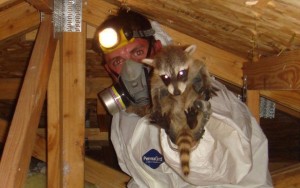 If you plan to remove the raccoon scat, and if you own this home shown in the picture above, you really should be removing the raccoon scat/insulation, and there is a proper way to do it. Raccoon scat is really considered a hazardous material kind of removal due to the possible harm that can come to any human that is doing the removal. All of the raccoon scat and raccoon scat must be removed. In addition, the insulation must also be removed. It has been in contact with the scat and it is also possible that it is soaked with the urine from the raccoons, particularly if they have been there for some time.
If you plan to remove the raccoon scat, and if you own this home shown in the picture above, you really should be removing the raccoon scat/insulation, and there is a proper way to do it. Raccoon scat is really considered a hazardous material kind of removal due to the possible harm that can come to any human that is doing the removal. All of the raccoon scat and raccoon scat must be removed. In addition, the insulation must also be removed. It has been in contact with the scat and it is also possible that it is soaked with the urine from the raccoons, particularly if they have been there for some time.
Safety Precautions
The proper process needs to be used to ensure that nothing escapes into the air and into the home. The person cleaning out the attic must follow proper procedures or remove this material which includes wearing protective clothing and an external breathing apparatus. Professional companies who do this sort of work will use a vacuum to suck all of the material up through a vacuum and into sealed bags that are disposed of at the appropriate facilities.
By following these procedures the people doing the removal are protected and your home and family are also protected as well. Nothing escapes into the air into your home to come in contact with anyone in your family. Nothing escapes and comes in contact with your clothing, your furniture or your floors while being removed. When the person who was in the attic leaves the attic they must follow a proper procedure to ensure that any material that is attached to his protective suit is not accidentally dislodged and left in your home. Most attics are entered through a trap door in the ceiling of your home and they must walk in the front door through the house to get to this trap door.
This is serious stuff and it is important to pay attention to this issue to protect the health of your family and yourself.
Why Trapping, Poisoning and Other methods do not Work
 If you just read the above paragraphs, you now realize how important it is to keep raccoons and other animals out of your home. If you see them, deal with it quickly before they do a lot of damage and leave a mess like this one shown in the picture. We have looked at numerous ways to remove raccoons and even tried some of them and frankly they were all a waste of time and just do not work with the exception of one approach.
If you just read the above paragraphs, you now realize how important it is to keep raccoons and other animals out of your home. If you see them, deal with it quickly before they do a lot of damage and leave a mess like this one shown in the picture. We have looked at numerous ways to remove raccoons and even tried some of them and frankly they were all a waste of time and just do not work with the exception of one approach.
Note that we are not selling anything here. We are so angry at all of these fake solutions. We wanted to make sure that people know about these things that do not work. They are a waste of time and money. We will quickly review some of the methods we read about and tried to find out that they did not have any impact at all.
The first thing you have to realize is that raccoons living in urban areas are used to humans. There are a lot of them and they move around from one den to another. If you did manage to get rid of the raccoons in your attic by whatever means, another family is just going to move in a few weeks or months later. So you need to have a permanent solution to this issue.
Things That do Not Work
We tried loud noise blasting in our attic. This had zero effect other than keeping us awake half the night. We tried mothballs and about the only thing this did was to make our attic smell like mothballs. The raccoons could have cared less. We did not try spreading dried urine from wolves in the attic. Apparently wolves are one of their enemies; however, would urban raccoons even know about this kind of enemy? We also did not want to make our attic smell any worse than it already did. We did not try poisoning the raccoons. There was concern they might die inside our attic. Or we might poison some neighborhood pets which would have been much worse. Finally, we tried trapping them with humane animal traps.
Raccoons are very smart and the older ones simply will not go inside a trap. They will reach through the wire mesh to get to the food you have left in there. But they will not walk into the trap. It ended up that was just giving them a nightly meal to munch on! We also found out that our city bylaws restrict us from moving a live animal more than two city blocks from where the raccoon was captured.
This is frankly ridiculous since raccoons will range this far in their nightly search for food. They will be back the next night! There is only one real way to get them out and keep them out of your attic. We will review it in the next section. It turns out that this is also the most humane way.
How to Remove Raccoons from Your Attic
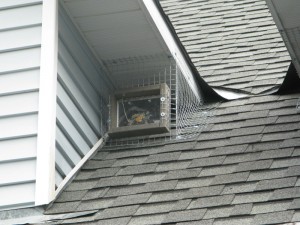 There are professional companies that do this work, however individual consumers can also install this solution themselves if they have the proper equipment and are not afraid to go up on the roof. This is an individual decision.
There are professional companies that do this work, however individual consumers can also install this solution themselves if they have the proper equipment and are not afraid to go up on the roof. This is an individual decision.
We opted for a professional company to do the work. It cost around $600 to get the raccoons out of our attic. Make sure that they are never getting back into our attic from any location again. Including the one that they used to get into our attic in the first place. It is important to do this quickly so that the raccoon scat and other damage does not accumulate.
The solution is to use a heavy gauge wire mesh. Screw nail it to the roof or the soffit area, wherever the raccoons are entering your attic. Use long screws to attach the wire in a solid manner so that it could not be pulled off. Before tightening the screws, place a large dab of silicon waterproof caulking where the screw nail enters the roof. This will prevent water from leaking in around the screw nail. You want to avoid rust. You also want to avoid water from getting in and causing the underlying wood to begin to rot. If you know that the raccoons and their babies are out of the den, install a permanent cover over the opening. Complete any repairs that are needed.
Install a One Way Trap Door
If you think that the raccoons are inside the attic when you are doing this work, you will have to install a one-way trap door. Which will allow them to get out of the den, but not back into the den. Wait a couple of weeks. Then you can remove the trap door and replace it with a permanent wire covering. At the same time cover, any other areas where the raccoons might be able to gain entry. Also, areas were squirrels and birds can get in. This is by far the best way to deal with raccoons in your home.
If you suspect that the babies are still inside, you are just going to have to wait. They must be old enough to travel on their own. The best approach is to wait until you actually see them outside the den in the early evening. Once you are sure that they are coming out of the dean, you can install the one-way trap door. Eventually, they will come out and not be able to come back inside the den.
We are suggesting this approach since the parents are very protective of their young. If the parents are prevented from getting into the den, they will literally try to take your roof apart to rescue them. Better off to wait until they are old enough and then install the one-way trap door. They can do far more damage to your roof. Then the rain or snow and wind can do far more damage!
Limit the Food Sources In Your Area
 Urban raccoons live in suburbia because there is lots of food around. Their favorite time is garbage day when there are lots of food scraps to be found. We have seen many garbage bags strewn along the road. Also, garbage cans tipped over from raccoons trying to follow their noses to some tantalizing food scraps. We wait until the morning to put our garbage out at the curb rather than provide a tasty meal for the local raccoons.
Urban raccoons live in suburbia because there is lots of food around. Their favorite time is garbage day when there are lots of food scraps to be found. We have seen many garbage bags strewn along the road. Also, garbage cans tipped over from raccoons trying to follow their noses to some tantalizing food scraps. We wait until the morning to put our garbage out at the curb rather than provide a tasty meal for the local raccoons.
Store your garbage inside as well to avoid tempting them during the week. Anything stored outside is going to be a place for them to look for food.
Deal With Grubs in Your Lawn
If you have grubs in your lawn, lookout. They love grubs and will dig up your lawn to get at them. If your lawn is not dying from the grubs getting at the roots. The lawn is going to be a mess from the grass being dug up by the raccoons. You can deal with grubs by asking your local lawn care company to spray your lawn in early spring or in late summer.
They love apples, fruit, grapes, and any other food item that might be found in your garden. Corn is a particular favorite for them in the fall. We recommend that you do an inventory of your property. Try to eliminate all food items that may be attractive to raccoons living in your area. The objective is to make your property as least attractive to raccoons as possible.
Good luck with removing raccoons from your property. Take special care in dealing with the removal of any raccoon scat.


